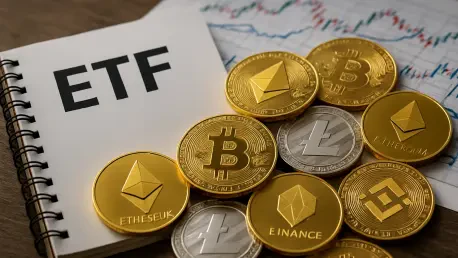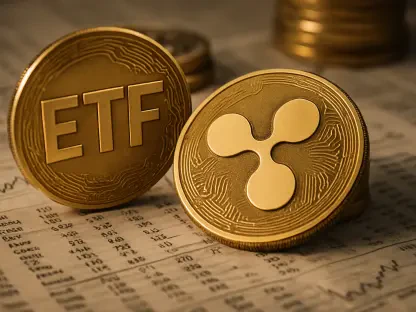In the ever-evolving cryptocurrency landscape, Solana (SOL), a prominent altcoin known for its high-speed blockchain, presents a baffling scenario that has captured the attention of investors and analysts alike, with a recent 5% price drop to $158.97 as of November 11. Despite this noticeable decline in its market price, institutional interest is reaching unprecedented heights through soaring volumes in exchange-traded funds (ETFs) and derivatives markets. This stark contrast between a bearish spot market and robust backing from big players raises critical questions about the forces at play. While retail traders grapple with short-term losses and technical indicators signaling caution, the surge in regulated investment vehicles suggests a deeper confidence in Solana’s future. This article aims to unpack the reasons behind this disconnect, exploring the dynamics of price weakness against the backdrop of institutional enthusiasm, and what it could mean for Solana’s trajectory in the crypto ecosystem.
Unpacking Institutional Enthusiasm
The institutional embrace of Solana stands in sharp relief to its struggling spot price, which has yet to breach the critical $175 resistance level. A pivotal development driving this interest is Grayscale’s innovative move to introduce options trading for its Solana ETF (GSOL) on NYSE Arca, marking a significant milestone for crypto investment products. This feature enables institutional investors to hedge their positions and manage risk while accessing staking rewards that average over 7%, all within a regulated and compliant framework. Such a structure not only bridges traditional finance with blockchain opportunities but also underscores a growing trust in Solana’s long-term value. This enthusiasm from major players suggests that, despite immediate market challenges, there is a belief in the altcoin’s potential to deliver substantial returns over time, positioning it as a serious contender in the institutional investment space.
Beyond Grayscale’s pioneering efforts, the broader Solana ETF market is witnessing remarkable momentum that further highlights this institutional confidence. On November 11, spot Solana ETFs recorded $7.9 million in fresh investments, continuing an impressive streak of 11 consecutive days of positive inflows. Since their debut in late October, these ETFs have accumulated a staggering $350.4 million in net inflows, with assets under management reaching $568.3 million, equivalent to roughly 0.6% of Solana’s circulating supply. This consistent capital influx, with contributions from both institutional and retail investors, sharply contrasts with the coin’s price struggles. It indicates a divide where market sentiment among day-to-day traders remains cautious, while larger investors are steadily building positions, betting on structural growth and future appreciation rather than short-term price movements.
Derivatives Market Dynamics
Another layer of institutional bullishness can be seen in the bustling activity within Solana’s derivatives market, which reflects speculative and strategic positioning by professional traders. According to data from Coinglass, options trading volume has surged by 52.49% to $2.71 million, while open interest has climbed 29.14% to $1.34 million. Additionally, futures trading volume experienced a modest increase of 0.81% to reach $17.26 billion. These metrics point to heightened engagement from sophisticated market participants who are likely preparing for or hedging against anticipated volatility. The availability of advanced financial products, such as the options tied to Grayscale’s GSOL, further fuels this trend by offering tools to navigate market uncertainties. This uptick in derivatives activity underscores a narrative of confidence among those with deeper market insights, even as the spot price fails to inspire similar optimism among retail investors.
The implications of this derivatives surge extend beyond mere numbers, painting a picture of a maturing market for Solana that is increasingly integrated into traditional financial strategies. The significant growth in open interest suggests that traders are not just engaging in short-term speculation but are establishing longer-term positions, possibly in anticipation of major price swings or structural shifts in the crypto landscape. This behavior contrasts with the hesitancy seen in the spot market, where price weakness dominates the conversation. The active involvement of professional traders through these instruments indicates a belief that Solana’s current challenges are temporary, and that upcoming developments or market conditions could catalyze a reversal. Such dynamics highlight how different segments of the market interpret Solana’s value proposition, with derivatives activity serving as a counterweight to the bearish signals seen elsewhere.
Technical Challenges in the Spot Market
Turning to the spot market, Solana’s price action reveals a more troubling story that explains much of the current downturn impacting retail sentiment. Technical analysis on the 4-hour chart displays clear bearish momentum, reinforced by a slightly negative Moving Average Convergence Divergence (MACD) indicator, which signals a lack of upward drive. While the Relative Strength Index (RSI) sits at 39.2, suggesting oversold conditions that could precede a rebound if buying pressure emerges, the absence of significant demand keeps the price pinned below key thresholds. This technical weakness is a primary factor driving the persistent decline, as many retail traders rely on these indicators to make decisions. The inability to overcome resistance levels like $175 fuels a cautious outlook, overshadowing the positive institutional developments that might otherwise bolster confidence among smaller investors.
Moreover, the broader market context adds to the challenges faced by Solana in the short term, as technical indicators alone do not tell the full story. The cryptocurrency space is often swayed by sentiment-driven movements, and Solana’s current price struggles may be amplified by broader uncertainties or profit-taking after earlier gains. Unlike institutional investors who can afford to play the long game, retail participants often react swiftly to negative chart patterns, leading to selling pressure that exacerbates the downturn. This creates a feedback loop where bearish signals discourage buying, further entrenching the price below critical levels. Until a catalyst emerges—whether from renewed retail interest or a breakout above resistance—the spot market is likely to remain a source of concern, even as other metrics point to underlying strength in Solana’s ecosystem.
Evolving Analyst Perspectives
Analyst views on Solana are undergoing a notable shift, reflecting the complex interplay between immediate market challenges and longer-term optimism. Nick Rook from LVRG Research has expressed surprise at the robust demand for Solana ETFs, noting that initial expectations were tempered by concerns over the altcoin’s volatility and its competitive positioning against Ethereum. However, the persistent inflows and institutional engagement suggest that many investors now see Solana as a high-yield complement to established cryptocurrencies like Bitcoin and Ethereum. This evolving perception indicates a willingness to accept higher risk for the possibility of greater returns, particularly as Solana’s unique attributes—like its speed and scalability—gain traction. Such sentiment highlights a growing acceptance of the altcoin as a vital component in diversified crypto portfolios.
This shift in perspective is not just academic but has tangible implications for how Solana is valued in the market. Analysts are beginning to focus less on day-to-day price fluctuations and more on the structural developments that could define its future. The sustained interest from institutional players, coupled with innovative products that cater to traditional finance, suggests that Solana is carving out a niche as a serious investment option. While volatility remains a hurdle, the narrative is increasingly about potential rather than pitfalls. This change in tone among experts could eventually filter down to retail investors, potentially bridging the gap between the current bearish sentiment and the bullish institutional actions. For now, though, the divide remains, with analyst optimism serving as a counterpoint to the immediate concerns dominating the spot market.
The Role of Regulated Financial Tools
The rise of regulated financial products like ETFs and derivatives options is reshaping Solana’s landscape in profound ways, offering a pathway for traditional finance to engage with the crypto space. These tools lower the barriers for institutional players, providing secure and familiar avenues to gain exposure to Solana without the complexities of direct ownership. The introduction of options trading through Grayscale’s GSOL is a prime example, allowing for sophisticated strategies like hedging while delivering staking yields. This integration not only boosts Solana’s appeal to larger funds and hedge portfolios but also enhances overall market liquidity and stability. Over time, such developments could help mitigate the price volatility that currently deters some investors, creating a more robust foundation for growth.
Furthermore, the impact of these regulated vehicles extends to the potential tightening of Solana’s circulating supply, a factor that could counterbalance current price weakness. As more assets are locked into ETFs and related products, the available supply for spot trading may decrease, potentially driving upward pressure on price if demand persists. This dynamic illustrates how institutional conviction, expressed through consistent capital inflows and innovative investment structures, lays the groundwork for long-term value appreciation. While the spot market continues to grapple with bearish trends, the broader trend of integration into traditional financial systems signals a maturing ecosystem. This evolution positions Solana as a credible option for diversified investment strategies, suggesting that the current disconnect between price and institutional interest may eventually resolve in favor of sustained growth.
Looking Ahead to Market Reconciliation
Reflecting on the journey, Solana faced a challenging period marked by a persistent price decline that saw it trading at $158.97 after a significant drop. Bearish technical indicators painted a cautious picture for retail traders, while institutional interest soared through record ETF inflows and derivatives activity. Innovations like Grayscale’s GSOL options trading underscored a growing confidence among larger investors, even as the spot market lagged. Moving forward, the focus should be on monitoring whether this institutional momentum can translate into broader market support. A potential rebound could hinge on retail sentiment catching up with the bullish signals from regulated products. Additionally, stakeholders might consider the impact of upcoming blockchain upgrades or market catalysts that could shift price dynamics. As Solana navigates this pivotal moment, balancing short-term challenges with long-term opportunities will be key to reconciling the current disparity and solidifying its place in the crypto investment landscape.









